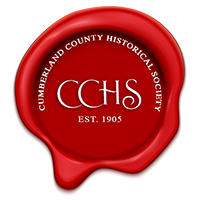New Update on the Cumberland County Log Stable (formerly the Swedish Granary)

In 2023 the New Jersey Historic Trust (NJHT) awarded the Cumberland County Historical Society a grant to fund a new Interpretive Plan for the Log Stable which sits behind the Gibbon House at 960 Ye Greate Street in Greenwich. This project is still ongoing and is anticipated to be completed by June 22, 2026.
To summarize briefly, the Log Stable was donated to the Society and moved to its present site in Greenwich in 1975 from the Fralinger Farm four miles away in Lower Hopewell Township–50 years ago! It was previously thought to have been built during the colonial Swedish period in the 17th century, thus its former name, the Swedish Granary. However, in 2014 a tree ring or dendrochronological project was undertaken by the team of Columbia professor Edward Cook and partner William Callahan. The building is comprised of Chamaecyparis thyoides or Atlantic White Cedar (AWC) logs, so core samples were taken from living AWC trees and historic building timbers by the team in order to construct a master chronology. First one and then a second grant was awarded by the New Jersey Historical Commission to support the project. In 2017 the project had amassed sufficient data to enable a new construction date for the building of 1783/84 (see the link for the Dendrochronology Progress Report of January 2017 below).
At this juncture it was felt that a new multi-faceted research project needed to be undertaken to learn more about the building and make possible a new and more accurate interpretation of it. To that end application was made to the NJHT for a grant to support such a project and, happily, in 2023 a $16,000 matching grant from the Preserve New Jersey Historic Preservation Fund was awarded. The new project would assemble a team of three subject matter experts as consultants who would perform relevant research and produce reports summarizing their results. A fourth consultant would then synthesize these reports into an Interpretive Plan to be submitted to the Society’s Board of Trustees for their review and feedback. At that point it will be hoped that the Interpretive Plan will provide direction to the Society with regard to the interpretation and preservation of the building.
The three subject matter experts are Historic Preservation Consultant Joan Berkey of Cape May Court House, NJ; Historic Structures Consultant Douglass Reed of Mercersburg, PA; and University of Delaware Department of Anthropology Professor Dr. Lu Ann De Cunzo of Greenwich NJ. Links to their reports are below. Consultants Berkey and Reed have completed their work. Consultant De Cunzo has completed one of two reports, the second one following in due time.
In fact, it was Joan Berkey’s historical research that identified the building as a stable for young livestock, a fact which overthrows the speculation that it had ever served as a granary or storage building.
The consultant writing the Interpretive Plan is Dr. James Turk of Mullica Hill, NJ. His work is in progress. Also contributing to the project is CCHS docent Joseph Mathews of Leesburg, NJ. Ashley Parker is the Program Officer assigned by the NJHT to the project.
Joseph Mathews, CCHS Building docent and Library Assistant
November 2, 2025
Doug Reed, “Origins, Significance, Use: The Cumberland County Log Out-Stable,” December 2023.

